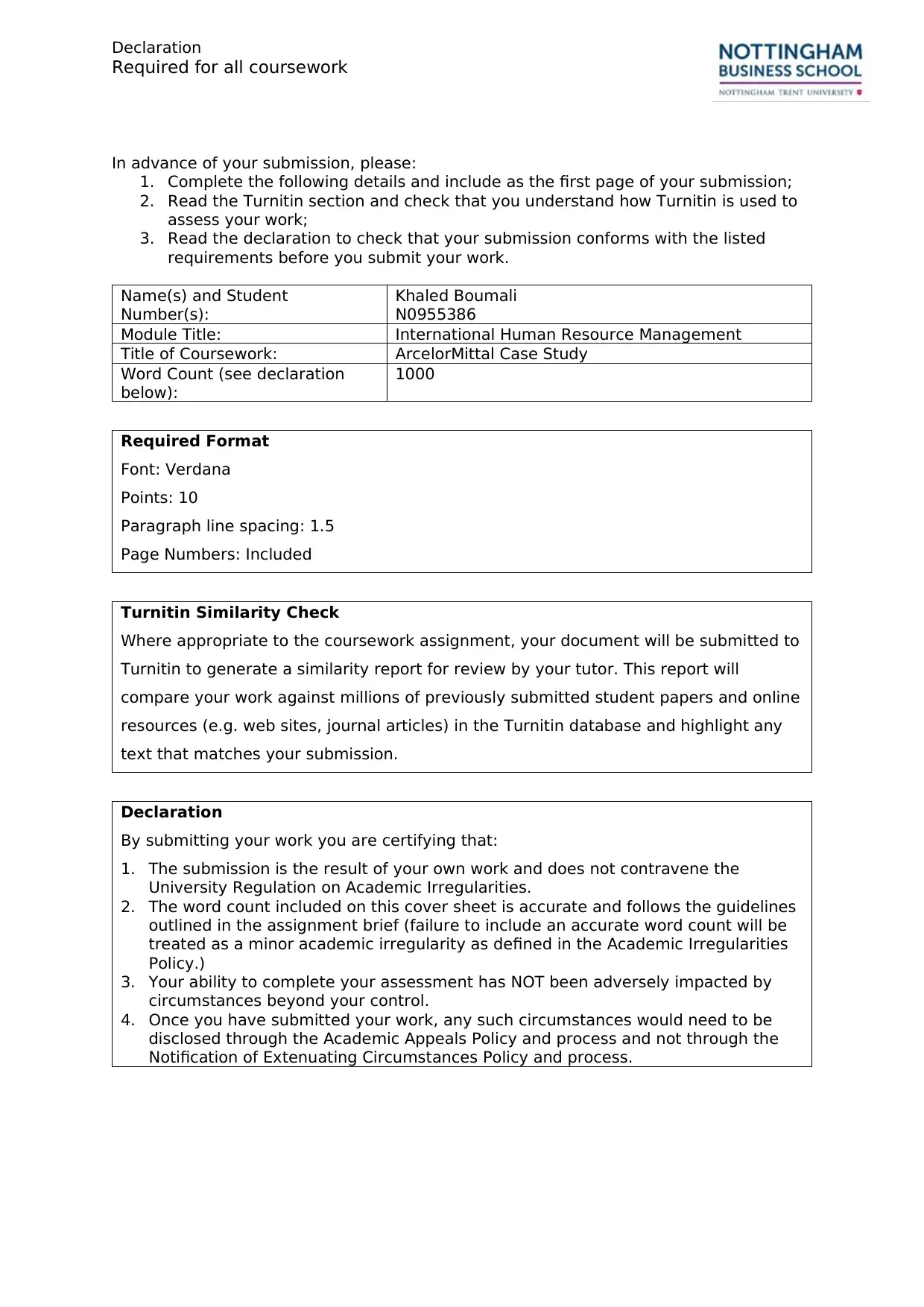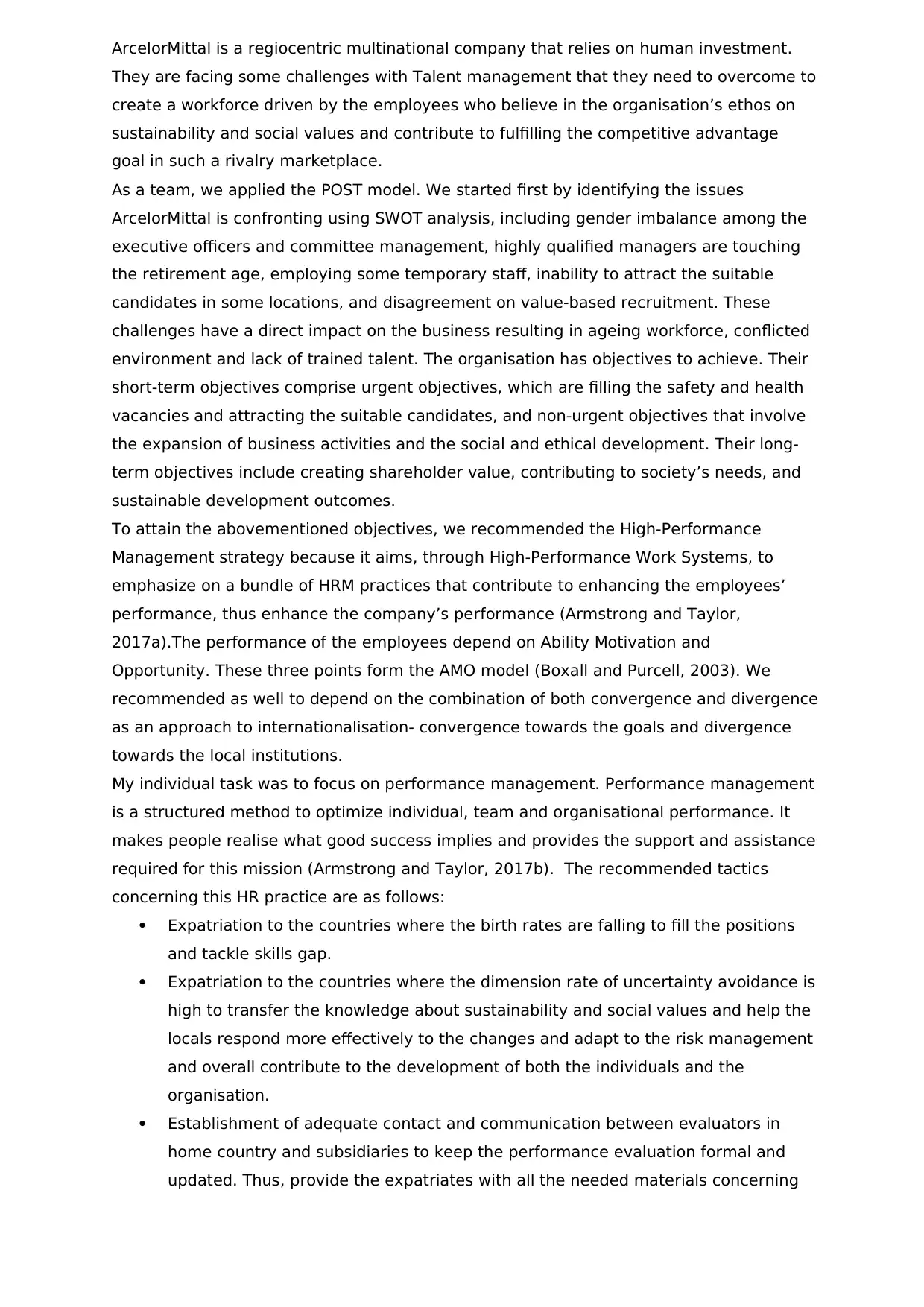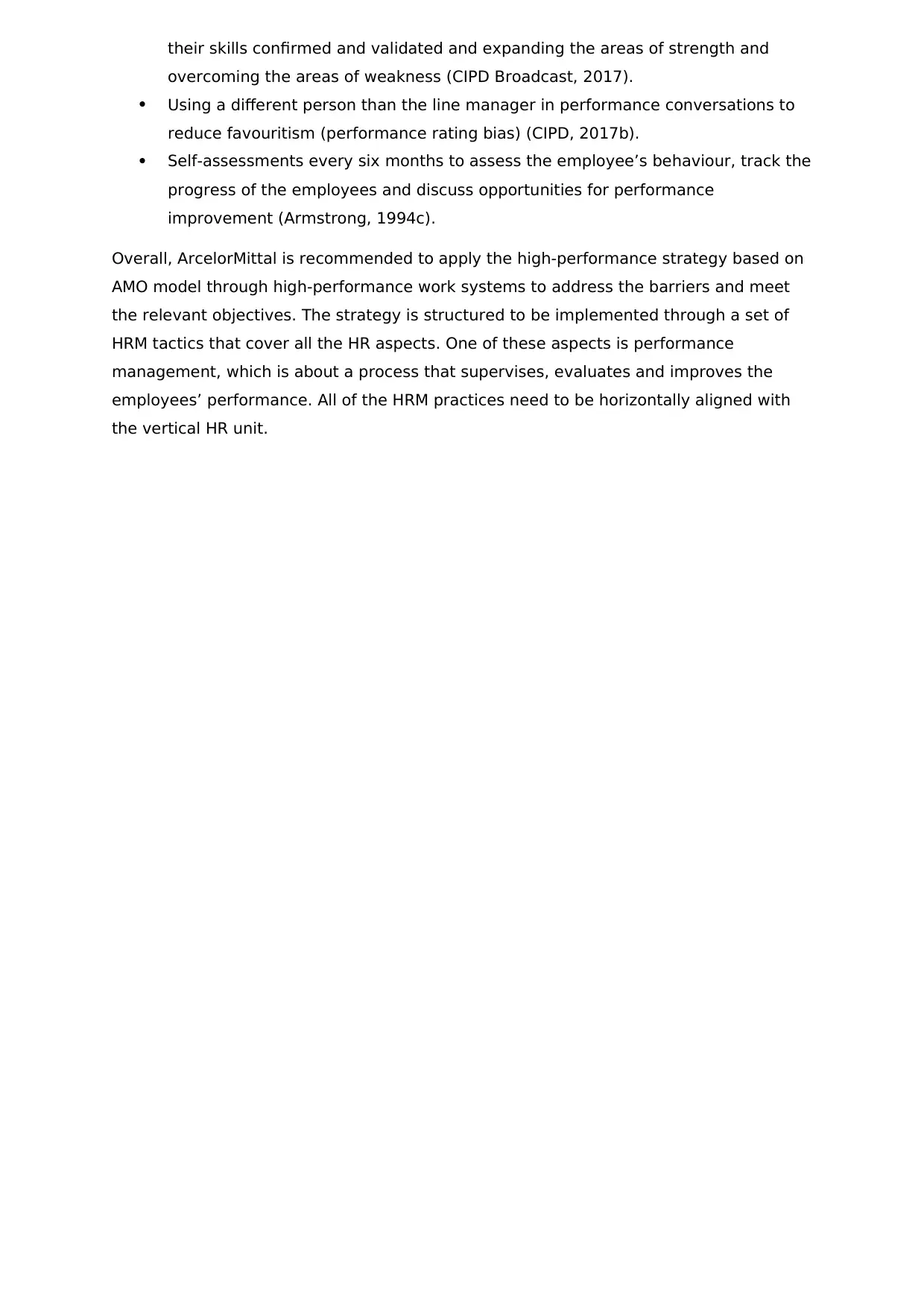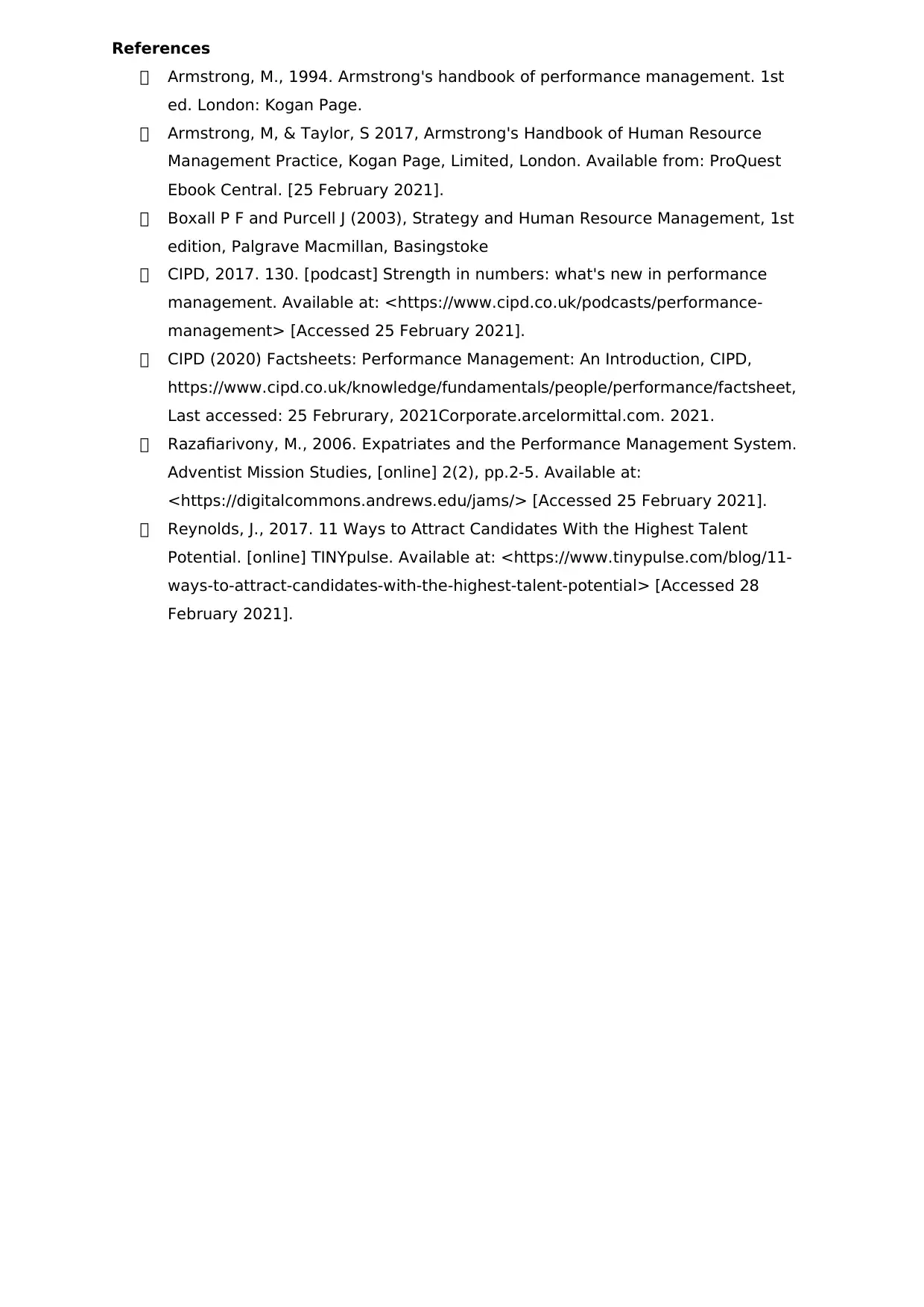International Human Resource Management: ArcelorMittal Case Study
VerifiedAdded on 2021/09/01
|5
|1693
|284
Case Study
AI Summary
This case study analyzes the HRM challenges faced by ArcelorMittal, a regiocentric multinational company, focusing on talent management and employee performance. The assignment identifies issues such as gender imbalance, an aging workforce, and difficulties in attracting suitable candidates. The solution proposes implementing a High-Performance Management strategy based on the AMO model, emphasizing HRM practices to enhance employee performance and align with the company's objectives. Recommendations include expatriation strategies, team building, performance appraisals, and linking rewards to performance. The study also stresses the importance of a performance plan that assesses employees on their productivity toward the company’s ethos on sustainability and social values, health and safety and guides all of them so that they can work with a common perception and understanding of the mission and the case goals of the company, i.e. building an alignment between the employees’ and the organisation’s goals. The document concludes by recommending a comprehensive approach to address barriers and achieve objectives through a set of horizontally aligned HRM tactics.

Declaration
Required for all coursework
In advance of your submission, please:
1. Complete the following details and include as the first page of your submission;
2. Read the Turnitin section and check that you understand how Turnitin is used to
assess your work;
3. Read the declaration to check that your submission conforms with the listed
requirements before you submit your work.
Name(s) and Student
Number(s):
Khaled Boumali
N0955386
Module Title: International Human Resource Management
Title of Coursework: ArcelorMittal Case Study
Word Count (see declaration
below):
1000
Required Format
Font: Verdana
Points: 10
Paragraph line spacing: 1.5
Page Numbers: Included
Turnitin Similarity Check
Where appropriate to the coursework assignment, your document will be submitted to
Turnitin to generate a similarity report for review by your tutor. This report will
compare your work against millions of previously submitted student papers and online
resources (e.g. web sites, journal articles) in the Turnitin database and highlight any
text that matches your submission.
Declaration
By submitting your work you are certifying that:
1. The submission is the result of your own work and does not contravene the
University Regulation on Academic Irregularities.
2. The word count included on this cover sheet is accurate and follows the guidelines
outlined in the assignment brief (failure to include an accurate word count will be
treated as a minor academic irregularity as defined in the Academic Irregularities
Policy.)
3. Your ability to complete your assessment has NOT been adversely impacted by
circumstances beyond your control.
4. Once you have submitted your work, any such circumstances would need to be
disclosed through the Academic Appeals Policy and process and not through the
Notification of Extenuating Circumstances Policy and process.
Required for all coursework
In advance of your submission, please:
1. Complete the following details and include as the first page of your submission;
2. Read the Turnitin section and check that you understand how Turnitin is used to
assess your work;
3. Read the declaration to check that your submission conforms with the listed
requirements before you submit your work.
Name(s) and Student
Number(s):
Khaled Boumali
N0955386
Module Title: International Human Resource Management
Title of Coursework: ArcelorMittal Case Study
Word Count (see declaration
below):
1000
Required Format
Font: Verdana
Points: 10
Paragraph line spacing: 1.5
Page Numbers: Included
Turnitin Similarity Check
Where appropriate to the coursework assignment, your document will be submitted to
Turnitin to generate a similarity report for review by your tutor. This report will
compare your work against millions of previously submitted student papers and online
resources (e.g. web sites, journal articles) in the Turnitin database and highlight any
text that matches your submission.
Declaration
By submitting your work you are certifying that:
1. The submission is the result of your own work and does not contravene the
University Regulation on Academic Irregularities.
2. The word count included on this cover sheet is accurate and follows the guidelines
outlined in the assignment brief (failure to include an accurate word count will be
treated as a minor academic irregularity as defined in the Academic Irregularities
Policy.)
3. Your ability to complete your assessment has NOT been adversely impacted by
circumstances beyond your control.
4. Once you have submitted your work, any such circumstances would need to be
disclosed through the Academic Appeals Policy and process and not through the
Notification of Extenuating Circumstances Policy and process.
Paraphrase This Document
Need a fresh take? Get an instant paraphrase of this document with our AI Paraphraser

ArcelorMittal is a regiocentric multinational company that relies on human investment.
They are facing some challenges with Talent management that they need to overcome to
create a workforce driven by the employees who believe in the organisation’s ethos on
sustainability and social values and contribute to fulfilling the competitive advantage
goal in such a rivalry marketplace.
As a team, we applied the POST model. We started first by identifying the issues
ArcelorMittal is confronting using SWOT analysis, including gender imbalance among the
executive officers and committee management, highly qualified managers are touching
the retirement age, employing some temporary staff, inability to attract the suitable
candidates in some locations, and disagreement on value-based recruitment. These
challenges have a direct impact on the business resulting in ageing workforce, conflicted
environment and lack of trained talent. The organisation has objectives to achieve. Their
short-term objectives comprise urgent objectives, which are filling the safety and health
vacancies and attracting the suitable candidates, and non-urgent objectives that involve
the expansion of business activities and the social and ethical development. Their long-
term objectives include creating shareholder value, contributing to society’s needs, and
sustainable development outcomes.
To attain the abovementioned objectives, we recommended the High-Performance
Management strategy because it aims, through High-Performance Work Systems, to
emphasize on a bundle of HRM practices that contribute to enhancing the employees’
performance, thus enhance the company’s performance (Armstrong and Taylor,
2017a).The performance of the employees depend on Ability Motivation and
Opportunity. These three points form the AMO model (Boxall and Purcell, 2003). We
recommended as well to depend on the combination of both convergence and divergence
as an approach to internationalisation- convergence towards the goals and divergence
towards the local institutions.
My individual task was to focus on performance management. Performance management
is a structured method to optimize individual, team and organisational performance. It
makes people realise what good success implies and provides the support and assistance
required for this mission (Armstrong and Taylor, 2017b). The recommended tactics
concerning this HR practice are as follows:
Expatriation to the countries where the birth rates are falling to fill the positions
and tackle skills gap.
Expatriation to the countries where the dimension rate of uncertainty avoidance is
high to transfer the knowledge about sustainability and social values and help the
locals respond more effectively to the changes and adapt to the risk management
and overall contribute to the development of both the individuals and the
organisation.
Establishment of adequate contact and communication between evaluators in
home country and subsidiaries to keep the performance evaluation formal and
updated. Thus, provide the expatriates with all the needed materials concerning
They are facing some challenges with Talent management that they need to overcome to
create a workforce driven by the employees who believe in the organisation’s ethos on
sustainability and social values and contribute to fulfilling the competitive advantage
goal in such a rivalry marketplace.
As a team, we applied the POST model. We started first by identifying the issues
ArcelorMittal is confronting using SWOT analysis, including gender imbalance among the
executive officers and committee management, highly qualified managers are touching
the retirement age, employing some temporary staff, inability to attract the suitable
candidates in some locations, and disagreement on value-based recruitment. These
challenges have a direct impact on the business resulting in ageing workforce, conflicted
environment and lack of trained talent. The organisation has objectives to achieve. Their
short-term objectives comprise urgent objectives, which are filling the safety and health
vacancies and attracting the suitable candidates, and non-urgent objectives that involve
the expansion of business activities and the social and ethical development. Their long-
term objectives include creating shareholder value, contributing to society’s needs, and
sustainable development outcomes.
To attain the abovementioned objectives, we recommended the High-Performance
Management strategy because it aims, through High-Performance Work Systems, to
emphasize on a bundle of HRM practices that contribute to enhancing the employees’
performance, thus enhance the company’s performance (Armstrong and Taylor,
2017a).The performance of the employees depend on Ability Motivation and
Opportunity. These three points form the AMO model (Boxall and Purcell, 2003). We
recommended as well to depend on the combination of both convergence and divergence
as an approach to internationalisation- convergence towards the goals and divergence
towards the local institutions.
My individual task was to focus on performance management. Performance management
is a structured method to optimize individual, team and organisational performance. It
makes people realise what good success implies and provides the support and assistance
required for this mission (Armstrong and Taylor, 2017b). The recommended tactics
concerning this HR practice are as follows:
Expatriation to the countries where the birth rates are falling to fill the positions
and tackle skills gap.
Expatriation to the countries where the dimension rate of uncertainty avoidance is
high to transfer the knowledge about sustainability and social values and help the
locals respond more effectively to the changes and adapt to the risk management
and overall contribute to the development of both the individuals and the
organisation.
Establishment of adequate contact and communication between evaluators in
home country and subsidiaries to keep the performance evaluation formal and
updated. Thus, provide the expatriates with all the needed materials concerning

their performance to avoid any kind of failure in their assignments, and help the
headquarters determine the stage through which the unit is going so that
adjustments can be made (Razafiarivony, 2006).
Making team building a top priority especially in the countries where the
collectivism dimension rate is high because locals are keen to working in team
(investment in the culture of locals) through reinforcing team performance
management to create enthusiasm for both the new and old employees and
retain them. Structuring a team performance plan that evaluates the employees’
performance towards diversity and inclusion to create a flexible and innovative
workforce that can help attract from a broader talent pool.
Extensive performance appraisal (in every term and after every training) to
monitor and examine the progress and the efforts of the employees towards
achieving the strategic objectives.
Regular Mutual feedback using the “Business Dashboard” to support the line
managers and make them conveniently skilled to work on achieving the relevant
objectives (CIPD, 2020a) and ensure that the process is performed accurately
within the organisational framework and reveal any adjustment difficulties
(Armstrong, 1994a).
Promotion of some experienced employees after revising their performance
appraisal records that show those who can fit the most the higher positions to
help fill the positions of the retired top managers. Internal promotion will even
attract the attention of suitable candidates and motivate the current employees.
Developing a performance plan that appraises the employees on their
productivity towards the company’s ethos on sustainability and social values
(moral aspect), health and safety and guides all of them so that they can work
with a common perception and understanding of the mission and the case goals
of the company, i.e. building an alignment between the employees’ and the
organisation’s goals
Highlighting and supporting the performance of the employees who take on
responsibilities outside of their job descriptions in the same framework to create
the culture of not being forced to do the same exact tasks every single day and
contribute to the development of the employees (Reynolds, 2017). Such a work
environment attracts the required job applicants even with the highest talent
potential.
Setting up links between rewards and performance to keep motivation persistent
among the employees (Armstrong, 1994b).
Making appraisal conversations beyond performance rating by investing in the
ideas that the employees may suggest to improve the workforce and overcome
any faced challenges during the work.
Applying the strength-based approach that focuses on the employees’ strengths
and the way to enlarge them, because the employees have a tendency to having
headquarters determine the stage through which the unit is going so that
adjustments can be made (Razafiarivony, 2006).
Making team building a top priority especially in the countries where the
collectivism dimension rate is high because locals are keen to working in team
(investment in the culture of locals) through reinforcing team performance
management to create enthusiasm for both the new and old employees and
retain them. Structuring a team performance plan that evaluates the employees’
performance towards diversity and inclusion to create a flexible and innovative
workforce that can help attract from a broader talent pool.
Extensive performance appraisal (in every term and after every training) to
monitor and examine the progress and the efforts of the employees towards
achieving the strategic objectives.
Regular Mutual feedback using the “Business Dashboard” to support the line
managers and make them conveniently skilled to work on achieving the relevant
objectives (CIPD, 2020a) and ensure that the process is performed accurately
within the organisational framework and reveal any adjustment difficulties
(Armstrong, 1994a).
Promotion of some experienced employees after revising their performance
appraisal records that show those who can fit the most the higher positions to
help fill the positions of the retired top managers. Internal promotion will even
attract the attention of suitable candidates and motivate the current employees.
Developing a performance plan that appraises the employees on their
productivity towards the company’s ethos on sustainability and social values
(moral aspect), health and safety and guides all of them so that they can work
with a common perception and understanding of the mission and the case goals
of the company, i.e. building an alignment between the employees’ and the
organisation’s goals
Highlighting and supporting the performance of the employees who take on
responsibilities outside of their job descriptions in the same framework to create
the culture of not being forced to do the same exact tasks every single day and
contribute to the development of the employees (Reynolds, 2017). Such a work
environment attracts the required job applicants even with the highest talent
potential.
Setting up links between rewards and performance to keep motivation persistent
among the employees (Armstrong, 1994b).
Making appraisal conversations beyond performance rating by investing in the
ideas that the employees may suggest to improve the workforce and overcome
any faced challenges during the work.
Applying the strength-based approach that focuses on the employees’ strengths
and the way to enlarge them, because the employees have a tendency to having
⊘ This is a preview!⊘
Do you want full access?
Subscribe today to unlock all pages.

Trusted by 1+ million students worldwide

their skills confirmed and validated and expanding the areas of strength and
overcoming the areas of weakness (CIPD Broadcast, 2017).
Using a different person than the line manager in performance conversations to
reduce favouritism (performance rating bias) (CIPD, 2017b).
Self-assessments every six months to assess the employee’s behaviour, track the
progress of the employees and discuss opportunities for performance
improvement (Armstrong, 1994c).
Overall, ArcelorMittal is recommended to apply the high-performance strategy based on
AMO model through high-performance work systems to address the barriers and meet
the relevant objectives. The strategy is structured to be implemented through a set of
HRM tactics that cover all the HR aspects. One of these aspects is performance
management, which is about a process that supervises, evaluates and improves the
employees’ performance. All of the HRM practices need to be horizontally aligned with
the vertical HR unit.
overcoming the areas of weakness (CIPD Broadcast, 2017).
Using a different person than the line manager in performance conversations to
reduce favouritism (performance rating bias) (CIPD, 2017b).
Self-assessments every six months to assess the employee’s behaviour, track the
progress of the employees and discuss opportunities for performance
improvement (Armstrong, 1994c).
Overall, ArcelorMittal is recommended to apply the high-performance strategy based on
AMO model through high-performance work systems to address the barriers and meet
the relevant objectives. The strategy is structured to be implemented through a set of
HRM tactics that cover all the HR aspects. One of these aspects is performance
management, which is about a process that supervises, evaluates and improves the
employees’ performance. All of the HRM practices need to be horizontally aligned with
the vertical HR unit.
Paraphrase This Document
Need a fresh take? Get an instant paraphrase of this document with our AI Paraphraser

References
Armstrong, M., 1994. Armstrong's handbook of performance management. 1st
ed. London: Kogan Page.
Armstrong, M, & Taylor, S 2017, Armstrong's Handbook of Human Resource
Management Practice, Kogan Page, Limited, London. Available from: ProQuest
Ebook Central. [25 February 2021].
Boxall P F and Purcell J (2003), Strategy and Human Resource Management, 1st
edition, Palgrave Macmillan, Basingstoke
CIPD, 2017. 130. [podcast] Strength in numbers: what's new in performance
management. Available at: <https://www.cipd.co.uk/podcasts/performance-
management> [Accessed 25 February 2021].
CIPD (2020) Factsheets: Performance Management: An Introduction, CIPD,
https://www.cipd.co.uk/knowledge/fundamentals/people/performance/factsheet,
Last accessed: 25 Februrary, 2021Corporate.arcelormittal.com. 2021.
Razafiarivony, M., 2006. Expatriates and the Performance Management System.
Adventist Mission Studies, [online] 2(2), pp.2-5. Available at:
<https://digitalcommons.andrews.edu/jams/> [Accessed 25 February 2021].
Reynolds, J., 2017. 11 Ways to Attract Candidates With the Highest Talent
Potential. [online] TINYpulse. Available at: <https://www.tinypulse.com/blog/11-
ways-to-attract-candidates-with-the-highest-talent-potential> [Accessed 28
February 2021].
Armstrong, M., 1994. Armstrong's handbook of performance management. 1st
ed. London: Kogan Page.
Armstrong, M, & Taylor, S 2017, Armstrong's Handbook of Human Resource
Management Practice, Kogan Page, Limited, London. Available from: ProQuest
Ebook Central. [25 February 2021].
Boxall P F and Purcell J (2003), Strategy and Human Resource Management, 1st
edition, Palgrave Macmillan, Basingstoke
CIPD, 2017. 130. [podcast] Strength in numbers: what's new in performance
management. Available at: <https://www.cipd.co.uk/podcasts/performance-
management> [Accessed 25 February 2021].
CIPD (2020) Factsheets: Performance Management: An Introduction, CIPD,
https://www.cipd.co.uk/knowledge/fundamentals/people/performance/factsheet,
Last accessed: 25 Februrary, 2021Corporate.arcelormittal.com. 2021.
Razafiarivony, M., 2006. Expatriates and the Performance Management System.
Adventist Mission Studies, [online] 2(2), pp.2-5. Available at:
<https://digitalcommons.andrews.edu/jams/> [Accessed 25 February 2021].
Reynolds, J., 2017. 11 Ways to Attract Candidates With the Highest Talent
Potential. [online] TINYpulse. Available at: <https://www.tinypulse.com/blog/11-
ways-to-attract-candidates-with-the-highest-talent-potential> [Accessed 28
February 2021].
1 out of 5
Related Documents
Your All-in-One AI-Powered Toolkit for Academic Success.
+13062052269
info@desklib.com
Available 24*7 on WhatsApp / Email
![[object Object]](/_next/static/media/star-bottom.7253800d.svg)
Unlock your academic potential
Copyright © 2020–2025 A2Z Services. All Rights Reserved. Developed and managed by ZUCOL.





